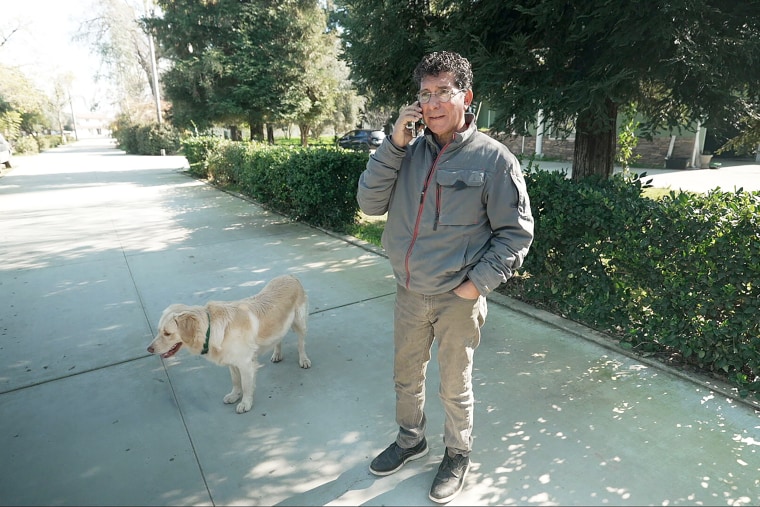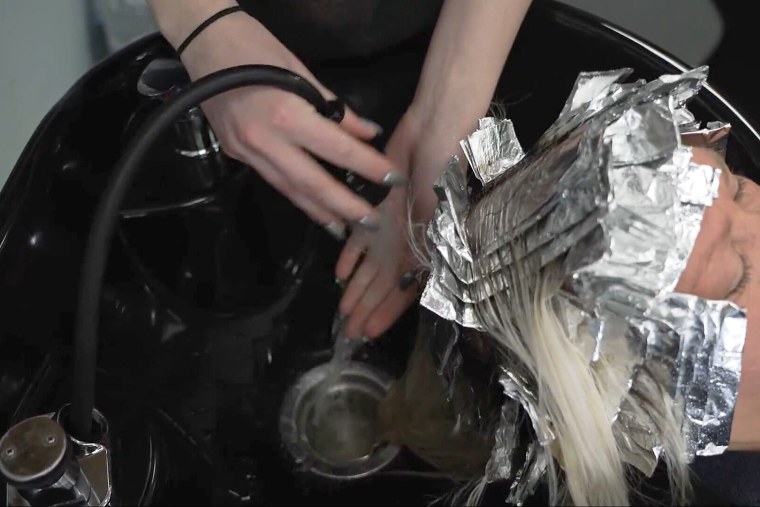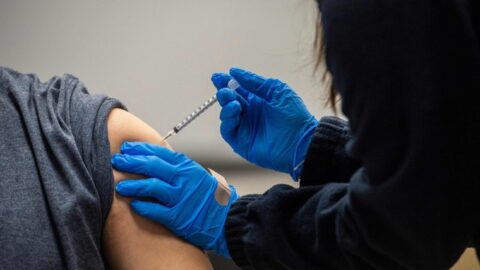CENTRAL VALLEY, Calif. — Though it was 40 years ago, Hector Corvera still remembers the uneasiness he felt when he cut someone’s hair for the very first time.
“Your first day out of beauty college, you’re nervous and you don’t want to mess up,” he said.
The onetime hairstylist was born and raised in California’s Central Valley to Mexican-American agricultural farmers. He grew up helping out during harvests. But by the end of high school, he was tired of the brutal work in the fields. Corvera wanted to find a different kind of profession. Hairdressing appealed to him because it would be less physical and bore the promise of cooler temperatures — he would never be out of work because people’s hair always grows, he thought.
He now believes the choice upended his life.
Corvera was diagnosed with bladder cancer in 2023. He recounted an unsettling moment with his urologist.
“He says, what do you do for a living? And I said, “I’m a hairdresser,” Corvera said the doctor answered, “Hmm, that explains it.”

Covera was too overwhelmed with his cancer diagnosis to push his doctor for more explanation. A few months later, he was approached by a law firm researching hair stylists who might be affected. And that led Corvera to look into whether his occupation and bladder cancer could be linked.
Corvera is suing beauty behemoth L’Oreal and 10 other companies alleging that his repeated exposure to certain carcinogenic chemicals in hair dyes caused his bladder cancer.
Filed in Los Angeles last month by attorney Allen Smith, the lawsuit states Corvera’s cancer diagnosis “was a direct and proximate result of the unreasonably dangerous and defective nature of the Defendants’ hair color products and the chemicals contained therein.” The complaint alleges the hair dye companies exhibited “wrongful and negligent conduct” in the research, development, testing and packaging of its products, among other instances.
Smith, the lawyer, is best known for taking on Johnson & Johnson in high-profile litigation over allegations that its talcum-based baby powder caused ovarian cancer. The baby powder lawsuits brought by more than 40 states resulted in a $700 million settlement. J&J replaced talc with cornstarch as the main ingredient in 2023 but did not admit to any wrongdoing. Smith said Corvera is one of many clients that he plans to represent in cases surrounding hair dye.
“We’re not talking about chemicals in hair dyes that might be carcinogenic or possibly carcinogenic. These are known chemicals that cause cancer,” Smith said.
Other hair care brands listed in the lawsuit include Wella, Clairol, John Paul Mitchell Systems, Joico and All Nutrients — which allegedly manufactured the dyes Corvera used in his 40-year career, according to the lawsuit.
Studies, some stretching back decades, have found an increased risk of cancer among hairdressers due to a group of harmful chemicals in hair dyes, commonly referred to as aromatic amines.
“Hair dyes are full of carcinogens,” said Anne McTiernan, an epidemiologist at the Fred Hutchinson Cancer Center in Seattle. “For hairdressers, it’s really clear that the occupation is problematic.”
A hairdresser’s exposure could be through both inhalation and through the skin, she said. It’s unclear whether ordinary latex gloves are protective.
According to the American Cancer Society, studies among people exposed to hair dyes at work, have found “a small but fairly consistent increased risk of bladder cancer.”
“It’s ruined my life. I’m not normal anymore, having to think of it every day, whether this is going to come back,” Corvera said.
Research into hair dye chemicals
The earliest peer-reviewed studies exploring whether hair dyes may cause cancer date back to the 1970s. A 1975 study tested approximately 170 permanent hair dyes and found that the vast majority of them altered the genetic makeup of a bacteria in a laboratory experiment, raising questions about its cancer-causing capability in humans.
At the same time, the National Cancer Institute was doing routine screening on hair dye ingredients and chemicals on laboratory animals. Results showed a major ingredient in hair dye caused cancer when fed to rodents.
In response, the cosmetic industry “reformulated coal-tar hair dye products” to remove certain harmful chemicals, according to the FDA. Coal-tar hair dyes are derived from petroleum and are no longer widely available on the market.
A follow-up study conducted by a government research center in 2003 discovered other harmful chemicals in commercial hair dyes.
The National Center for Toxicological Research, part of the FDA, highlighted that 4-aminobiphenyl, an aromatic amine known as 4-ABP, appeared in eight out of 11 tested U.S. commercial hair dye products, “in black, red and blonde hair dyes but not in brown hair dye.” The hair dyes tested were from both home-dying kits and salon-based products.
The discovery of 4-ABP in dyes was significant because it is a known human carcinogen that can cause bladder and liver cancer.
The authors of the 2003 study called for more research to see if 4-ABP “contributes to the increased risk of bladder cancer reported in frequent users of hair dyes.”
More than 20 years later, half a dozen researchers and doctors told NBC News that some modern hair dyes still contain 4-ABP and other aromatic amines that are harmful because of their ability to damage DNA. Due to its carcinogenicity, commercial production of 4-aminobiphenyl ceased in the United States in the 1950s.
“There are actually many chemicals that are toxic that are in these products,” said Adana Llanos, an associate professor of epidemiology at Columbia University. “How is it that 4-ABP is still being found in modern-day hair dye? That chemical in particular, and many others should not be in products that people have easy access to because we know they are harmful and toxic.”
Llanos, who focuses some of her laboratory research on chemical exposure from personal care products and health equity, said that these chemicals are not listed on the product’s label because they only materialize either through the manufacturing process or when the dye is mixed with hydrogen peroxide and color accelerant in the salon.
A lack of federal regulation on cosmetics results in little transparency for the consumer, Llanos said.

“When products are screened through mass spectrometry, what investigators have found is that there are chemicals that are not disclosed on ingredients lists that are found in these products,” Llanos said. Mass spectrometry is a sophisticated type of testing that identifies unlisted chemicals or components in a solution.
NBC News reached out to the FDA, asking about whether hair manufacturers have ever told the agency that they removed carcinogenic aromatic amines like 4-ABP. A spokesperson for the agency responded that “under the law, cosmetic products and ingredients generally do not need FDA premarket approval, and hair dye manufacturers are not obliged to inform FDA if they choose to remove coal-tar hair dyes from their products.”
Because of these chemicals, numerous large-sample and comparative studies have found that hairdressers are at a higher risk of developing bladder cancer. In a 2010 analysis of more than 42 prior studies, German researchers found “an increased and statistically significant risk for bladder cancer among hairdressers,” particularly if they’ve been in the profession for more than 10 years.
“That’s an important piece of information in all of this, increased dose equals increased risk,” McTiernan, the epidemiologist, said.
“This corroborates the interpretation that there is a causal association between bladder cancer and a job held as a hairdresser,” the study concluded.
Based on scientific studies published in 2010, the World Health Organization’s cancer research wing, IARC, classified the hairdressing occupation as “probably carcinogenic to humans,” citing “consistent evidence” of “excess risk” for bladder cancer in hairdressers and barbers. The cancer agency’s report into 4-APB cites animal studies on dogs, mice and bacteria, as well as experimental human studies.
Based on what’s known about the chemicals and their harm to bacteria and animals, McTiernan said the existing evidence has shown strong associations between hairdressers and bladder cancer risk.
“There’s no benefit to inject people or cover them with hair dye to see what’s going to happen to their cancer risk,” she said, referring to the possibility of conducting human trials.
Is there a risk to using hair dye?
While evidence for cancer risk among hair care professionals is relatively robust, less is known about the health risks for women who frequently use permanent dye to color their hair. The research so far is inconclusive.
The WHO’s cancer agency’s designation for hairstylists does not extend to people who dye their hair. That remains “not classifiable.”
Nothing has been published to determine a definitive link between cancer and women who dye their hair. Experts concur it would be significant research for the tens of millions of women in the U.S. who dye their hair each year.
Alexandra Wright is a principal investigator at the National Institutes of Health, with a research focus on breast cancer. She co-authored the 2020 Sister Study that used data from nearly 47,000 women — the largest study of its kind — to examine if there was any association between cancer risk and hair dye.
She said her study “provides strong scientific evidence in support of the link” between an increased risk of breast cancer and women who use permanent hair dye.
However, the study only pointed to an association between hormone-related cancers and hair dye use. It does not imply causation — only that the two things are happening simultaneously.
Wright found women who regularly used permanent hair dye in the year before enrolling in the study were 9% more likely to develop breast cancer than women who did not use the products. The study found women of color had a much more elevated risk — a 60% increased risk compared to 8% for white women.
“The findings from the Sister Study definitely do raise some eyebrows,” Tiffany Onger, an oncologist at the Cleveland Clinic said. “They were able to find this relationship or association that people who use permanent hair dye, regularly, have a higher risk of developing cancer, breast cancer, compared to people who don’t, and that risk was even more pronounced for Black women.”
Other factors that can elevate the risk, according to the study, include what shade of hair dye is being used and how long someone has been dying their hair.
“We saw that women who use darker shades of hair dye have a substantially higher risk,” Llanos said, owing to the fact that a greater concentration of chemicals are needed to achieve darker pigmentation.
“We know that Black women and African American women due to the color of their hair, in particular if they’re covering grays, are going to tend to use darker hair dyes to try to match their natural hair color. But it’s actually these darker dyes that are more problematic,” Onger added.
A 2020 study published in the BMJ medical journal found that there was no positive association between personal use of permanent hair dye and risk for most cancers. There was a “slightly higher risk observed of basal cell carcinoma, three types of breast cancer, and ovarian cancer,” according to the study’s lead researcher Yin Zhang.
“Current evidence regarding the carcinogenic potential of permanent hair dye use is inconclusive,” Zhang said.
Ensuring products are safe
The FDA has faced criticism in the past for not doing more to regulate potentially harmful cosmetic products. But aside from food additives, the FDA doesn’t require any safety checks for cosmetic products and ingredients the way it does with drugs. It’s up to the companies that manufacture and sell them to ensure such products are safe for consumers.
The lawsuit involving Hector Corvera accuses prominent hair dye manufacturers of misrepresenting to the FDA that they removed carcinogenic chemicals from the products decades ago, arguing that in fact these chemicals persist in commercial hair dyes today.
“Cosmetics undergo no FDA testing before they go on the market. So the guinea pigs, so to speak, are the people that use or wear the cosmetics,” Smith said.
NBC News reached out to all companies listed in the complaint and asked them to provide clarity on whether aromatic amines, including 4-ABP, are still in their products, and if there are any efforts to make safer hair dyes.
Most did not respond to multiple requests for comment or declined to comment on the lawsuit.
One of the beauty companies being sued, Coty, said they no longer make or sell hair dye products in the U.S., adding “the claims against Coty are unsubstantiated and without merit.” Similarly, Bristol Myers Squibb said it had “no liability” for products manufactured by Clairol, which it sold in 2001.
Where does that leave hairdressers and women who frequently dye their hair?
Onger said she regularly fields questions from her breast cancer patients about whether they should dye their hair after chemotherapy.
“I let my patients know that there is potentially an association, and data and studies are ongoing to try to understand this relationship,” Onger said. “But if one wants to really minimize their risk, I generally recommend that we try to avoid it if possible. There’s a lot of social pressure for women to alter their appearance, and I want my patients to be able to make decisions that are right for themselves.”
McTiernan said commissioning studies on safety and more protective gear may be necessary to limit exposure for both hairdressers and clients.
“Could masking help them get less inhalation exposure, for example, and would they just need to do it while they’re applying the product? Have their clients do that too?” McTiernan said. “Or more ventilation? Maybe that’s enough. What kind of gloves are helpful for them?”
Without a complete list of ingredients on packaging, experts say it’s a challenge for stylists and their customers to protect themselves.
As for Corvera, he hopes this lawsuit will inspire change when it comes to how these products are distributed and marketed.
“I think they need to be clear and honest with the consumer and tell them what’s in the product,” Corvera said of the hair care companies.
“Give some warnings if there is such a thing that is causing this and be honest with the people.”









Recent Comments